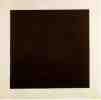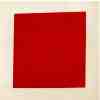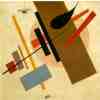![]()
Kasimir Malevich's art and his Suprematist manifesto are amongst the most vital artistic developments of this century. Most of his paintings are limited to geometric shapes and a narrow range of colors, but the pinnacle of his Suprematism was his White on White series. He claimed to have reached the summit of abstract art by denying objective representation.
Although Chagall and Soutine both left Russia to seek inspiration in France, the early 20th century saw an amazing renewal in Russian art. Since the far-off days of the icon painters, there had been nothing in this great country but the monotony of academic art. Now, as if unconsciously anticipating the coming revolution of 1917, one great painter after another appeared. They were not universally welcomed in their homeland, and more than one artist sought a response elsewhere, but some of the most significant painters dedicated their lives and their art to their country.
They are difficult artists. Kasimir Malevich (1878-1935), who founded what he called Suprematism, believed in an extreme of reduction: ``The object in itself is meaningless... the ideas of the conscious mind are worthless''. What he wanted was a non-objective representation, ``the supremacy of pure feeling.'' This can sound convincing until one asks what it actually means. Malevich, however, had no doubts as to what he meant, producing objects of iconic power such as his series of White on White paintings or Dynamic Suprematism (1916; 102 x 67 cm (40 x 26 1/2 in)), in which the geometric patterns are totally abstract.
Malevich had initially been influenced by Cubism and primitive art, which were both based on nature, but his own movement of Suprematism enabled him to construct images that had no reference at all to reality. Great solid diagonals of color in Dynamic Suprematism are floating free, their severe sides denying them any connection with the real world, where there are no straight lines. This is a pure abstract painting, the artist's main theme being the internal movements of the personality. The theme has no precise form, and Malevich had to search it out from within the visible expression of what he felt. They are wonderful works, and in their wake came other powerful Suprematist painters such as Natalia Goncharova and Liubov Popova.
 Black Circle
Black Circle
[1913] 1923-29; Oil on canvas, 105.5 x 105.5 cm (41 1/2 x 41 1/2 in);
State Russian Museum, St. Petersburg
 Black Square
Black Square
[1913] 1923-29; Oil on canvas, 106.2 x 106.5 cm (41 3/4 x 41 7/8 in);
State Russian Museum, St. Petersburg
 Black Square and Red Square
Black Square and Red Square
1915; Oil on canvas, 71.4 x 44.4 cm (28 x 17 1/2 in);
The Museum of Modern Art, New York
 Suprematist Painting: Aeroplane Flying
Suprematist Painting: Aeroplane Flying
1915; Oil on canvas, 57.3 x 48.3 cm (22 5/8 x 19 in);
The Museum of Modern Art, New York
 Suprematist Composition
Suprematist Composition
1915; Oil on canvas, 70 x 47 cm (27 5/8 x 18 1/2 in);
Fine Arts Museum, Tula
 Red Square: Painterly Realism of a Peasant Woman in Two Dimensions
Red Square: Painterly Realism of a Peasant Woman in Two Dimensions
1915; Oil on canvas, 53 x 53 cm (20 7/8 x 20 7/8 in);
State Russian Museum, St. Petersburg
 Suprematism
Suprematism
1915; Oil on canvas, 87.5 x 72 cm (34 1/2 x 28 3/8 in);
State Russian Museum, St. Petersburg
 Suprematism: Self-Portrait in Two Dimensions
Suprematism: Self-Portrait in Two Dimensions
1915; Oil on canvas, 80 x 62 cm (31 1/2 x 24 3/8 in);
Stedelijk Museum, Amsterdam
 Suprematist Painting
Suprematist Painting
1915-16; Oil on canvas, 49 x 44 cm (19 1/4 x 17 3/8 in);
Wilhelm Hacke Museum, Ludwigshafen
 Suprematist Painting
Suprematist Painting
1916; Oil on canvas, 88 x 70 cm (34 5/8 x 27 5/8 in);
Stedelijk Museum, Amsterdam
 Supremus No. 56
Supremus No. 56
1916; Oil on canvas, 80.5 x 71 cm (31 3/4 x 28 in);
State Russian Museum, St. Petersburg
 Suprematism (Supremus No. 58)
Suprematism (Supremus No. 58)
1916; Oil on canvas, 79.5 x 70.5 cm (31 1/4 x 27 3/4 in);
State Russian Museum, St. Petersburg
 Suprematism
Suprematism
1916-17; Oil on canvas, 80 x 80 cm (31 1/2 x 31 1/2 in);
Fine Arts Museum, Krasnodar
 Suprematist Painting
Suprematist Painting
1917; Oil on canvas, 96.5 x 65.4 cm (38 x 25 3/4 in);
The Museum of Modern Art, New York